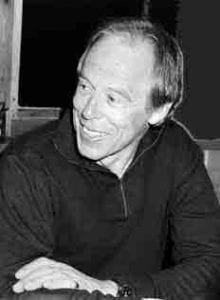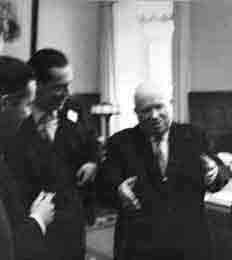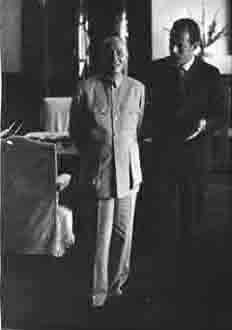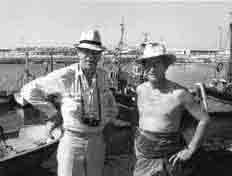
Tom Stacey’s adventurous life has given him extraordinary tales to tell. A born writer, he offers us reflective wisdom put down memorably and pleasurably in a unique voice. His work has been acclaimed by writers as varied as Nina Bawden, Sybille Bedford, Orville Prescott, Rowan Williams, Christopher Hill and John Gray who described The Man Who Knew Everything as ‘a near-forgotten masterpiece’ when naming it as his joint Book of the Year for the New Statesman – ‘one of the few books I’ve ever read that I finished in one sitting and then immediately had to read again’.
‘Brilliant, penetrating and justly observed,’ wrote Myrna Blumberg in The Times on The Living and the Dying (1976).
Tom Stacey’s work has frequently been chosen by leading critics as their Books of the Year and has been compared to the work of such varied writers as Graham Green, E M Forster, John Banville and the 17thc. divine, Jeremy Taylor.
First entering equatorial east Africa’s glacier-clad Mountains of the Moon almost sixty years ago, Stacey has been repeatedly caught up in the turbulent history of the region’s Bakonzo tribe, among whom he is now a revered elder. His salient work, Tribe, is a major piece of travel literature and an ‘autobiography’ of a place and its people in whose tempestuous advance towards kingdomhood he has been a key player. Tribe was chosen by the historian Felipe Fernandez-Armesto as his Book of the Year for The Times Literary Supplement, describing it as ‘triumphantly defying every literary shibboleth, unfolding and important document or the history of the end of the British empire’.

Born in 1930, Stacey grew up in London and the Scottish Highlands and was educated at Eton and briefly at Oxford. He edited The Eton College Chronicle with Douglas Hurd, won the Essay Prize, founded the philosophical Wotton’s Society — which flourishes to this day — and was a solo chorister. He was commissioned in the Scots Guards, and aged 19 was sent combat the Chinese guerrilla insurrection in Malaya. On leave from duties he disappeared into the jungle and lived with aboriginal Temiar tribe. The diary he kept of this journey resulted in the book The Hostile Sun, awarded The John Llewellyn Rhys Memorial Prize.
His career as a journalist kicked off when he became staff writer for Picture Post at 22. He moved to the Daily Express, and then the Sunday Times as Chief Roving Foreign Correspondent. In 1961 he received the Granada Award for Journalism as Foreign Correspondent of the Year. The John Simpson of his day, Stacey covered major events worldwide from the Congo, S.E. Asia and the Middle East to the Bay of Pigs. He interviewed legendary world leaders Khrushchev in the Kremlin, Indira Gandhi, Salvador Allende, Ayub Khan, Chiang Kai-Shek, and African leaders Amin, Obote, Lumumba, Nyerere, Kaunda… He extensively chronicled the dismantling of the British empire, writing from more than 120 coutries.
Aged 24, Tom Stacey’s overland journey across Africa with an Oxbridge friend Erisa Kironde ended in his prolonged study of the Bakonzo of the Ruwenzori Mountains. Stacey’s combined experience inspired his internationally acclaimed, landmark novel, The Brothers M. About two soulmates, black and white, and the communication and conflict between two worlds, it offered a deeper understanding of the African dilemma than any hitherto published work. In 1962 his trusted Konzo guide and mentor fomented armed tribal rebellion in the Mountains of the Moon, which Stacey had unwittingly seeded. The following year he was invited by Uganda’s Milton Obote to try to help settle the revolt. This experience informed Stacey’s next work of non-fiction, Summons to Ruwenzori.

Stacey’s reputation grew with subsequent novels, receiving rapturous reviews: The Living and the Dying (1976), The Pandemonium (1980), The Twelfth Night of Ramadan (1983), The Worm in the Rose (1985), and Deadline (1988) which was dramatised for TV starring John Hurt. To distinguish the novel from the film, the editing of which outraged the author; the latest edition of the work, slightly revised, was newly entitled The Man Who Knew Everything (Capuchin Classics, 2008). The novel Decline followed in 1991.
Meanwhile Tom Stacey’s first collection of long-short stories, Bodies and Souls (1989), has been followed by a steady stream of shorter fiction, mostly published in the US literary journal Confrontation, and include: The Same Old Story (1997), The Tether of the Flesh (1998), Golden Rain (2001), Grief (2004), The Swap (2006) and Mary’s Visit (2008), and The Kelpie from Rhum (2009). Publication of these and other shorter fiction, in collected volume form, is in view, as is a new ambitious work of fiction, A Dark and Stormy Night.
As a publisher, Tom Stacey launched the international current affairs service for schools and colleges, ‘Correspondents Worldwide’, in 1968, assembling the talents of several distinguished former colleagues of international journalism, and later sold to Pergamon. In 1969 his first book-publishing imprint Tom Stacey Ltd, whose wide range of titles and publishing projects included the (ecological) ‘Prospect for Man’ series, and under Stacey’s editorial supervision, the 20-volume ‘Peoples of the Earth’ direct mail series, ultimately published in 14 languages. Alongside the main international field of the Stacey publishing programme, Tom Stacey has used his publishing vehicles to champion campaigns or causes of his own special interest by commissioning authors, partnering authors, and initiating series. These initiatives have included:
- Drug addict rehabilitation (lead author James Norman)
- Legalisation of all drugs multilaterally (lead author Max Rendall)
- Ecological balance (lead author and series editor Edward Goldsmith)
- Control of Immigration (lead contributor Enoch Powell)
- Scientific counter-consensus on anthropogenically induced climate change (leader authors Andrew Montford, Robert Carter, Fritz Vahrenholt and Sebastian Lüning)
Tom Stacey commissioned the five-year research and worldwide publication of The Concise Encyclopaedia of Islam (Cyril Glasse), and is the dedicatee of the work.
Stacey’s first eponymous imprint was superseded in 1974 by Stacey International, with which he has remained associated while ceasing executive function. Originally specializing in works about Islam, Africa, and Asia, the imprint has expanded into UK-based general publishing.

His considerable energy led him into national affairs in the 1960s and saw him standing twice for Parliament for the Conservatives. In 1967 he withdrew from his candidature at an eminently winnable seat at Dover on the grounds of public life blunting creative spontaneity. Becoming, however, a prison visitor in 1974, in 1981 he conceived the electronic tagging of offenders in lieu of custody to reduce reoffending, taking his feasibility study to the Home Office and launching the Offender’s Tag Association in 1982. He remains Director of that research and lobbying group. He has seen the introduction of the idea into the penological tariff in Britain since 1989 and the subsequent nationwide usage of the electronic tag in the monitoring of offenders or bailees, and the spread of the sanction around the world. Stacey is repeatedly called upon by the media to explain or defend the method and value of tagging, as the scheme approaches the availability of round-the-clock surveillance by means of the satellite tag.
In 1999 Stacey conceived and organised Pilgrimage 2000 in which Christians of all denominations joined in walking towards Canterbury from eight sacred sites (Iona, Lindisfarne, St David’s Head, St Michael’s Mount, Whitby, Holywell, Walsingham, and St Paul’s Cathedral), each converging to herald the Third Millennium at January 1 2000.
Tom Stacey and his wife, the widely-exhibited sculptor Caroline Stacey, have five children, numerous grandchildren and great-grandchildren. He was elected a Fellow of the Royal Society of Literature in 1976.
